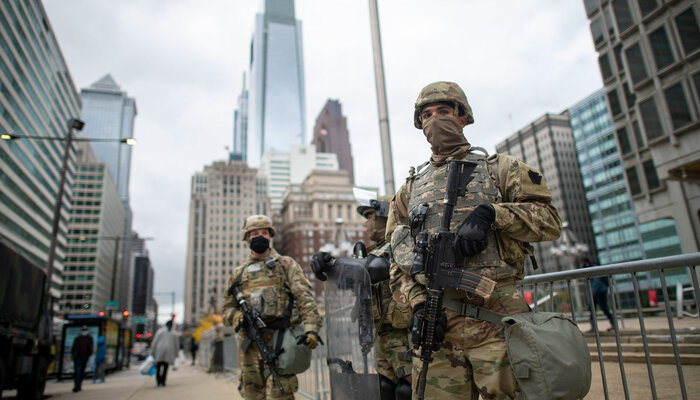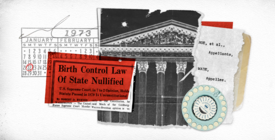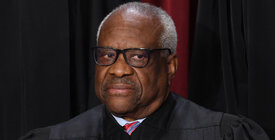The Insurrection Act Explained
The law, which lets the president deploy the military domestically and use it for civilian law enforcement, is dangerously vague and in urgent need of reform.

The Insurrection Act needs a major overhaul. Originally enacted in 1792, the law grants the president the authority to deploy the U.S. military domestically and use it against Americans under certain conditions. While there are rare circumstances in which such authority might be necessary, the law, which has not been meaningfully updated in over 150 years, is dangerously overbroad and ripe for abuse.
What is the Insurrection Act?
The Insurrection Act authorizes the president to deploy military forces inside the United States to suppress rebellion or domestic violence or to enforce the law in certain situations. The statute implements Congress’s authority under the Constitution to “provide for calling forth the Militia to execute the Laws of the Union, suppress Insurrections and repel Invasions.” It is the primary exception to the Posse Comitatus Act, under which federal military forces are generally barred from participating in civilian law enforcement activities.
Although it is often referred to as the “Insurrection Act of 1807,” the law is actually an amalgamation of different statutes enacted by Congress between 1792 and 1871. Today, these provisions occupy Sections 251 through 255 in Title 10 of the United States Code.
What does invoking the Insurrection Act allow the president and military to do?
Under normal circumstances, the Posse Comitatus Act forbids the U.S. military — including federal armed forces and National Guard troops who have been called into federal service — from taking part in civilian law enforcement. This prohibition reflects an American tradition that views military interference in civilian government as being inherently dangerous to liberty.
Invoking the Insurrection Act temporarily suspends the Posse Comitatus rule and allows the president to deploy the military to assist civilian authorities with law enforcement. That might involve soldiers doing anything from enforcing a federal court order to suppressing an uprising against the government. Of course, not every domestic use of the military involves law enforcement activity. Other laws, such as the Stafford Act, allow the military to be used to respond to natural disasters, public health crises, and other similar events without waiving the restrictions of the Posse Comitatus Act.
In theory, the Insurrection Act should be used only in a crisis that is truly beyond the capacity of civilian authorities to manage. However, the Insurrection Act fails to adequately define or limit when it may be used and instead gives the president significant power to decide when and where to deploy U.S. military forces domestically.
When can the president invoke the Insurrection Act?
Troops can be deployed under three sections of the Insurrection Act. Each of these sections is designed for a different set of situations. Unfortunately, the law’s requirements are poorly explained and leave virtually everything up to the discretion of the president.
Section 251 allows the president to deploy troops if a state’s legislature (or governor if the legislature is unavailable) requests federal aid to suppress an insurrection in that state. This provision is the oldest part of the law, and the one that has most often been invoked.
While Section 251 requires state consent, Sections 252 and 253 allow the president to deploy troops without a request from the affected state, even against the state’s wishes. Section 252 permits deployment in order to “enforce the laws” of the United States or to “suppress rebellion” whenever “unlawful obstructions, combinations, or assemblages, or rebellion” make it “impracticable” to enforce federal law in that state by the “ordinary course of judicial proceedings.”
Section 253 has two parts. The first allows the president to use the military in a state to suppress “any insurrection, domestic violence, unlawful combination, or conspiracy” that “so hinders the execution of the laws” that any portion of the state’s inhabitants are deprived of a constitutional right and state authorities are unable or unwilling to protect that right. Presidents Dwight D. Eisenhower and John F. Kennedy relied on this provision to deploy troops to desegregate schools in the South after the Supreme Court’s landmark decision in Brown v. Board of Education.
The second part of Section 253 permits the president to deploy troops to suppress “any insurrection, domestic violence, unlawful combination, or conspiracy” in a state that “opposes or obstructs the execution of the laws of the United States or impedes the course of justice under those laws.” This provision is so bafflingly broad that it cannot possibly mean what it says, or else it authorizes the president to use the military against any two people conspiring to break federal law.
Who decides when the conditions for deployment have been met?
Nothing in the text of the Insurrection Act defines “insurrection,” “rebellion,” “domestic violence,” or any of the other key terms used in setting forth the prerequisites for deployment. Absent statutory guidance, the Supreme Court decided early on that this question is for the president alone to decide. In the 1827 case Martin v. Mott, the Court ruled that “the authority to decide whether [an exigency requiring the militia to be called out] has arisen belongs exclusively to the President, and . . . his decision is conclusive upon all other persons.”
However, while this precedent might prevent judges from second-guessing whether the president is allowed to invoke the Insurrection Act in response to a given situation, the Supreme Court clarified in Sterling v. Constantin (1932) that courts may still review the lawfulness of the military’s actions once deployed. In other words, federal troops are not free to violate other laws or trample on constitutional rights just because the president has invoked the Insurrection Act.
Is invoking the Insurrection Act the same as declaring martial law?
The Insurrection Act does not authorize martial law. The term “martial law” has no established definition, but it is generally understood as a power that allows the military to take over the role of civilian government in an emergency. By contrast, the Insurrection Act generally permits the military to assist civilian authorities (whether state or federal), not take their place. Under current law, the president has no authority to declare martial law.
How has the Insurrection Act been used in the past?
The Insurrection Act has been invoked numerous times throughout American history for a variety of purposes. Presidents George Washington and John Adams used it in response to early rebellions against federal authority. President Abraham Lincoln invoked it at the start of the Civil War, and President Ulysses Grant used it to crush the first incarnation of the Ku Klux Klan in the 1870s. Several other presidents, including Andrew Jackson, Rutherford Hayes, and Grover Cleveland, have deployed troops under the Insurrection Act to intervene in labor disputes, invariably on the side of employers. Most famously, Presidents Eisenhower, Kennedy, and Lyndon B. Johnson all invoked the Insurrection Act during the civil rights movement to enforce federal court orders desegregating schools and other institutions in the South.
When was the Insurrection Act last invoked?
The Insurrection Act was last invoked in 1992, when the governor of California requested military aid from President George H.W. Bush in response to civil unrest in Los Angeles that followed the acquittal of four white police officers charged with beating Black motorist Rodney King. At 29 years and counting, this is the longest period the United States has ever gone without an invocation of the Insurrection Act.
No president has unilaterally invoked the Insurrection Act against a state’s wishes since Lyndon Johnson did so to provide protection for civil rights activists in Alabama marching from Selma to Montgomery in 1965.
How should the Insurrection Act be reformed?
The lack of clear standards within the Insurrection Act itself, combined with the Supreme Court’s ruling in Martin v. Mott, has created a situation where the president has almost limitless discretion to deploy federal troops in cases of civil unrest. Such unbounded authority to use the military domestically has always been dangerous. In the 21st century, it is also unnecessary and untenable. The United States has changed profoundly in the 150 years since the Insurrection Act was last amended, as have the capabilities of state and federal civilian authorities and the expectations of the American people. The Insurrection Act — arguably the most potent of the president’s emergency powers — should reflect those realities.
To address these concerns, Congress should amend the Insurrection Act to define more clearly and precisely what situations may trigger it. Congress also should establish mechanisms for review of the president’s decision that will guard against abuse while still preserving the president’s flexibility in a crisis.






